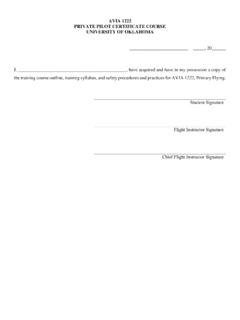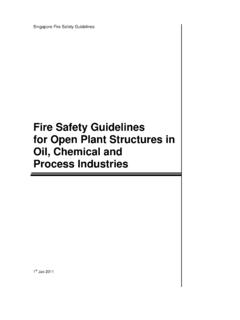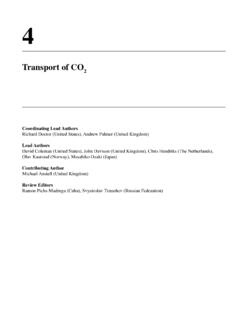Transcription of OIL AND GAS SEPARATION DESIGN MANUAL - University of …
1 OIL AND GAS SEPARATION DESIGN MANUAL BY C. RICHARD SIVALLS, SIVALLS, INC. BOX 2792 ODESSA, TEXAS 79760 All rights reserved. This publication is fully protected by copyright and nothing that appears in it may be printed, either wholly or in part, without special permission. Revised February 10, 2009 SIVALLS, OIL AND GAS SEPARATION - DESIGN MANUAL TABLE OF CONTENTS Technical Bulletin No. 142 Oil and Gas SEPARATION DESIGN and Sizing Introduction 1 Internal Construction of Separators 1-2 separator Types 2-3 Factors Affecting SEPARATION 3-4 separator DESIGN Gas Capacity 4-5 Liquid Capacity 6 Other Types of SEPARATION Equipment 6-7 Conclusion 7 Example Problems 8-9 Figure 1 - Gas Capacity of Vertical Separators 10 Figure 2A & 2B - Gas Capacity of Vertical Separators 11-1 2 Figure 3 - Gas Capacity of Horizontal Separators 13 Figure 4A & 4B - Gas Capacity of Horizontal Separators 14-1 5 Figure 5A & 5B - Liquid Capacity of Horizontal Separators 16-1 7
2 Figure 6 - Gas Capacity of Spherical Separators 18 Figure 7 - Gas Capacity of Spherical Separators 19 Figure 8 & 9 - Vertical Oil-Gas Separators 10-2 1 Figure 10 - Horizontal Oil-Gas Separators 22 Figure 11 - Vertical Oil-Gas-Water Separators 23 Figure 12 - Horizontal Oil-Gas-Water Separators 24 Figure 13 - Spherical Oil-Gas Separators 25 Figure 14 - Spherical Oil-Gas Separators 25 Figure 15 - Horizontal Double Tube Separators 26 Table 1A & 1B - Specifications, Vertical Separators 27 Table 2A & 2B - Specifications, Vertical Separators 28-2 9 Table 3A & 3B - Specifications, Horizontal Separators 30 Table 4A & 4B - Specifications, Horizontal Separators 31-3 2 Table 5A, 5B, 5C - Specifications, Spherical Separators 33-3 4 References 34 Technical Bulletin No.
3 159 Two Stage SEPARATION System Introduction 1 Two Stage SEPARATION 1-2 Description of Process 2 Gas and Liquid Increase 2-3 Economics 3 Figure 1 - Schematic Flow Diagram 4 Figure 2 - Gas from Flash separator 5 Figure 3 - Stock Tank Liquid Increase 6 Technical Bulletin No. 162 Filter Separators General 1 Process Description 1 Horizontal Filter Separators 1 Vertical Filter Separators 1-2 Filter separator Sizing 2 Conclusion 2 Table 1 & 2 - Correction Factor 2 Figure 1 & 2 - Gas Capacity of Horizontal Filter Separators 3-4 Figure 3 & 4 - Gas Capacity of Vertical Filter Separators 5-6 Figure 5 - Horizontal Filter Separators 7 Figure 6 - Vertical Filter Separators 8 Table 3 & 4 - Specifications of Filter Separators 9 Technical Bulletin No.
4 163 Low Temperature Gas SEPARATION Units General 1 Process Application 1 Equipment Description 1-3 Estimated Recoveries 3 Figure 1 - Flow Diagram, Low Temperature SEPARATION Unit 4 Figure 2 - Effect of Temperature on Liquid Recovery 5 References 6 Technical Bulletin No. 177 Vertical Gas Scrubbers Introduction 1 Construction 1 Scrubber DESIGN 1-2 Conclusion 2 Table 1 - Correction Factors 3 Table 2 - Specifications of Vertical Gas Scrubbers 3 Figure 1 - Gas Capacity of Vertical Gas Scrubbers 4 Figure 2 - Vertical Gas Scrubber 5 - 1 - SIVALLS, SECTION: 300 TECHNICAL BULLETIN No. 142, Rev. 7 February 10, 2009 OIL AND GAS SEPARATION DESIGN AND SIZING INTRODUCTION: Hydrocarbon streams as produced at the wellhead are composed of a mixture of gas, liquid hydrocarbons and sometimes free water. In most cases it is desirable to separate these phases as soon as possible after bringing them to the surface and handle or transport the two or three phases separately.
5 This SEPARATION of the liquids from the gas phase is accomplished by passing the well stream through an oil-gas or oil-gas-water separator . Different DESIGN criteria must be used in sizing and selecting a separator for a hydrocarbon stream based on the composition of the fluid mixture. In the case of low pressure oil wells, the liquid phase will be large in volume as compared to the gas phase. In the case of high pressure gas-distillate wells the gas volume will be higher as compared to the liquid volume. The liquid produced with high pressure gas is generally a high API gravity hydrocarbon, usually referred to as distillate or condensate. However, both low pressure oil wells and high pressure gas-distillate wells may contain free water. Separators are used in many other locations other than wellhead production batteries, such as gasoline plants, upstream and downstream of compressors, and liquid traps in gas transmission lines.
6 They are also found on inlets to dehydration units, gas sweetening units, et cetera. At some of these locations separators are referred to as knockouts, free liquid knockouts, and traps. Sometimes these vessels are called scrubbers. Caution should be used when referring to a vessel required for gas/liquid SEPARATION as a scrubber. Within the gas industry there is another type of vessel often called a scrubber. This is one that is designed to handle a gas stream with only trace amounts of free liquid present in the gas. They are not designed using the same criteria as is used for gas/liquid SEPARATION where appreciable amounts of liquid are present or where liquid slugging maybe encountered. However, all of the vessels mentioned above that are designed to separate gas and free liquids serve the same primary purpose. This technical paper is concerned primarily with the use of separators in field installations.
7 The theory and basic DESIGN criteria will be the same no matter where they are located or their basic use. INTERNAL CONSTRUCTION OF SEPARATORS: The principal items of construction that should be present in a good liquid-gas separator are the same regardless of the overall shape or configuration of the vessel. Some of these features are itemized as follows: 1. A centrifugal inlet device where the primary SEPARATION of the liquid and gas is made; 2. A large settling section of sufficient length or height to allow liquid droplets to settle out of the gas stream with adequate surge room for slugs of liquid; 3. A mist extractor or eliminator near the gas outlet that will coalesce small particles of liquid that will not settle out by gravity; 4. Adequate controls consisting of level controller , liquid dump valve, gas back pressure valve, safety relief valve, pressure gauge, level gauge, instrument gas regulator and piping .
8 It has been found that the bulk of gas-liquid SEPARATION takes place in the inlet centrifugal separating section. - 2 - Here the incoming stream is spun around the walls of a small cylinder or usually the walls of the vessel in the case of a vertical or spherical separator . This subjects the fluids to a centrifugal force up to five hundred times the force of gravity. This action stops the horizontal motion of the free liquid entrained in the gas stream and forces the liquid droplets together, where they will fall to the bottom of the separator in the settling section. The settling section is necessary to allow the turbulence of the fluid stream to subside and allow the liquid droplets to fall to the bottom of the vessel, due to the difference in the gravity between the liquid and gas phases. A large open space in the vessel has been found adequate for this purpose. Introduction of special quieting plates or baffles with narrow openings only complicates the internal construction of the separator and provides places for sand, sludge, paraffin, et cetera, to collect and eventually plug up the vessel and stop the flow.
9 It has been found that the SEPARATION of liquid and gas using the centrifugal inlet feature and a large open settling section will produce a more stable liquid product, which can be obtained in atmospheric or low pressure storage tanks. Minute scrubbing of the gas phase by use of internal baffling or plates may produce more liquid to be discharged from the separator , but it will not be a stable product, since the light ends will be entrained in it, and therefore more vapor losses will be incurred from the storage system. Sufficient surge room should be allowed in the settling section to handle slugs of liquid without carry over to the gas outlet. This can be accomplished to some extent by the placement of the liquid level controller in the separator , which in turn determines the liquid level. The amount of surge room required is often difficult, if not impossible, to determine based on well test or flowing data. In most cases the separator size used for a particular application is often a compromise between initial cost and possible surging requirements.
10 Another major item required to effect good and complete liquid-gas SEPARATION is a mist eliminator or extractor near the gas outlet. Small liquid droplets that will not settle out of the gas stream, due to the little or no gravity difference between them and the gas phase, will be entrained and pass out of the separator with the gas. This can be almost eliminated by passing the gas through a mist eliminator near the gas outlet which has a large surface impingement area. The small liquid droplets will hit the surfaces, coalesce and collect to form larger droplets which will then drain by gravity back to the liquid section in the bottom of the vessel. It is believed that the stainless steel woven wire mist eliminator is the most efficient type, and has been proven by removing up to or more of the entrained liquids from the gas stream. This type offers the greatest surface area for the collection of liquid droplets per unit volume as compared to vane types, ceramic packing or other configurations.





